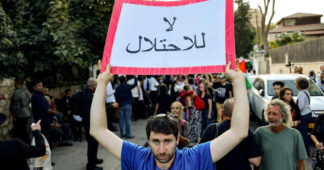By Ofer Aderet
Even half a century later, reading minutes from the Israel Defense Forces’ Judea and Samaria Division discussions is difficult. Each step in the establishment of a West Bank settlement is cataloged, step by step, from planning to execution.
The first step was dispossessing residents of the nearby Palestinian village of their land under the false pretext of making it a military training zone. When the Palestinians insisted on cultivating the land, Israeli soldiers sabotaged their tools. Soldiers were later ordered to use vehicles to destroy the crops. A radical solution was employed when this failed: a crop duster spread a toxic chemical. The substance was lethal for animals and dangerous for humans.
The story briefly made headlines in 1972 when it was reported in foreign media. It didn’t prevent the establishment of the settlement of Gitit on land confiscated from residents of the village of Aqraba, which the military had poisoned. The full details of the affair have been revealed 51 years later, thanks to a new project by the Taub Center for Israel Studies at New York University.
The project maps and catalogs all available historical data dealing with Israeli settlements. For the first time, thousands of sealed files from the Israel State Archives and other libraries have been opened for public inspection and shed light on one of the most significant movements in Israeli history.
Military files held in the IDF’s archives preserve documents detailing the spraying in Aqraba. The first document in the file dates to January 1972, when the IDF Central Command ordered the Jordan Valley Brigade to ensure that “no land is cultivated,” including using vehicles to destroy existing agriculture.
A document from March that same year states that the mission was unsuccessful. At the IDF Samaria Division’s headquarters, the Custodian of Absentee Property summoned Palestinian village chiefs and leaders of family clans to remind them “not to violate the instructions.” He threatened that otherwise, their crops would be destroyed and that they would be “prosecuted for unlicensed entry into a closed [military] zone.”
Another document in the same file recorded how the IDF had instructed an investigation into an officer who “caused damage to residents’ property.” According to the file, an officer and several soldiers damaged a tractor that belonged to Palestinians, including their plow and herds. However, the file has no record of the trial or punishment imposed on the soldiers, if this was true.
The military took another step in April 1972. A discussion held at its Central Command with the participation of officers, a representative of the settlements department at the Jewish Agency, and the Custodian of Absentee Property was titled “Spraying the irregular areas in the Tel-Tal sector.” Tel-Tal eventually became Gitit.
According to the document, the purpose of the meeting was to establish “responsibility and schedule for the spraying.” It also stated that for three days after the spraying, no one was to enter the area “for fear of stomach poisoning.” Animals, the document said, were not allowed to enter for an additional week.
The document further reveals that an IDF General Staff officer estimated that damage to Palestinians due to the spraying would amount to 12,000 to 14,000 Israeli pounds (equaling around $25,000 today). The Jewish Agency was given the job of obtaining the plane. Its representative was tasked with “coordinating with Chemair,” a crop-dusting company owned by local kibbutzim and moshavim and run as a cooperative.
Another meeting was held later that month. “There is no objection from this command to carrying out the spraying as planned,” read the minutes. “The Custodian of Absentee Property will see to it that the area’s borders are marked accurately and will direct the plane accordingly.” Those attending also agreed that compensation would be granted to the Palestinians “if lawsuits are filed.”
Other documents in the file reveal that the spraying of the area of 500 dunams, which aimed to “destroy the harvest,” was carried out on April 17 after “the operation was approved by the Coordinator of Government Activities in the Territories.” It further states that the military had allocated “an amount of 14,000 Israeli pounds for a one-time compensation to crop owners who were affected by the spraying.”
Continue reading at archive.is
We remind our readers that publication of articles on our site does not mean that we agree with what is written. Our policy is to publish anything which we consider of interest, so as to assist our readers in forming their opinions. Sometimes we even publish articles with which we totally disagree, since we believe it is important for our readers to be informed on as wide a spectrum of views as possible.










